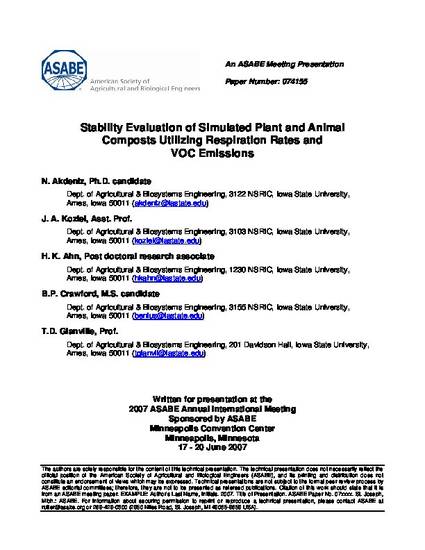
Article
Stability Evaluation of Simulated Plant and Animal Composts Utilizing Respiration Rates and VOC Emissions
Agricultural and Biosystems Engineering Conference Proceedings and Presentations
Document Type
Conference Proceeding
Disciplines
Conference
2007 ASABE Annual International Meeting
Publication Date
6-1-2007
Geolocation
(44.983334, -93.26667)
Abstract
Composting livestock carcasses is an economically and biologically safe method to convert carcasses into odorless, humus like material useful as a soil amendment. One of the key factors to determine the quality of the end product is stability. In this study, mortality composting is simulated using a laboratory set-up operating under aerobic and anaerobic conditions. 85 µm Carboxen/PDMS SPME fiber coating and 10 minutes sampling time are used to sample headspace of decaying plant (corn silage) and animal (shredded whole pig body) tissues. Compounds are separated and identified on a multidimensional gas chromatography-mass spectrometry-olfactometry (MDGC-MS-O) system. Sulfur containing compounds (methyl mercaptan, carbondisulfide, dimethyl disulfide, dimethyl trisulfide, 1,4-dimethyl tetra sulfide) and 1-H-indole and 3-methyl-1H-indole are found as indicators of decaying animal tissue. Peak area counts of these compounds show a decrease after eight week composting time. This trend in VOC emissions can be explained by decrease in the microbial activity and stabilization of the composts. These results are also supported with respirometric measurements. The measured respiration rates of aerobically composted animal tissues during 60 days are half of the respiration rates of fresh animal tissues. Also, a significant difference is observed in VOC emissions from plant and animal materials composted under aerobic and anaerobic conditions. The number of detected compounds during anaerobic decomposition is twice as much as the ones detected under aerobic decomposition. It can be concluded that monitoring VOC emissions can be a useful tool to estimate aeration status and completion of real life mortality composts.
Copyright Owner
American Society of Agricultural and Biological Engineers
Copyright Date
2007
Language
en
Citation Information
Neslihan Akdeniz, Jacek A. Koziel, Heekwon Ahn, Benjamin P. Crawford, et al.. "Stability Evaluation of Simulated Plant and Animal Composts Utilizing Respiration Rates and VOC Emissions" Minneapolis, MN(2007) Available at: http://works.bepress.com/thomas_glanville/13/

This is an ASABE Meeting Presentation, Paper No. 074155.